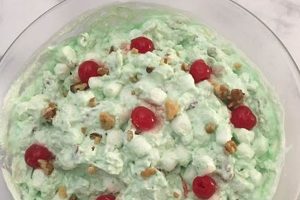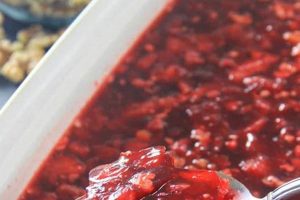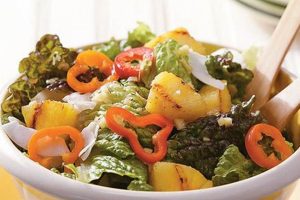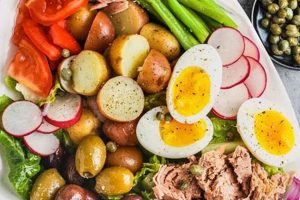A classic spinach salad typically features fresh spinach leaves as the base, complemented by hard-boiled eggs, bacon bits, and a warm vinaigrette dressing. Variations might include mushrooms, red onion, croutons, or cheese. The defining characteristic is the contrast between the cool, slightly bitter spinach and the warm, savory dressing, often featuring bacon fat as a key ingredient.
This style of salad offers a nutritional and flavorful meal option. Spinach provides essential vitamins and minerals, while the other components contribute protein and healthy fats. Its popularity endures due to the balance of textures and tastes, satisfying a range of palates. Historically, wilted spinach salads, dressed with a hot bacon vinaigrette, were a common way to prepare this leafy green, particularly in regions where fresh produce availability fluctuated.
Further exploration will delve into specific ingredient choices, dressing variations, and preparation techniques to achieve the perfect balance of flavors and textures in this timeless dish. Nutritional information and suggested pairings will also be addressed.
Tips for a Classic Spinach Salad
Achieving a truly delicious spinach salad relies on careful attention to detail. These tips will help ensure optimal flavor and texture.
Tip 1: Baby Spinach vs. Mature Spinach: While both can be used, baby spinach offers a more tender texture, ideal for salads. Mature spinach may require removing the stems and chopping the leaves.
Tip 2: High-Quality Bacon: The bacon contributes significantly to the flavor profile. Opt for thick-cut, smoked bacon for the best results.
Tip 3: Proper Egg Cooking: Overcooked egg yolks can be dry and crumbly. Aim for a firm, yet creamy yolk by cooking for about 8-10 minutes.
Tip 4: Warm Dressing is Key: The heat of the dressing slightly wilts the spinach and enhances the flavor absorption. Ensure the dressing is warm when poured over the salad.
Tip 5: Balancing the Vinaigrette: A balance of sweet and acidic elements in the vinaigrette is crucial. Adjust the ratio of vinegar and sweetener (such as sugar or maple syrup) to taste.
Tip 6: Adding Other Ingredients: Mushrooms, red onions, and croutons provide textural and flavor complexity. Add them sparingly to avoid overwhelming the spinach.
Tip 7: Timing is Everything: Assemble the salad just before serving. This prevents the spinach from becoming soggy and maintains the crispness of other components.
By following these guidelines, one can create a spinach salad that offers a satisfying and flavorful culinary experience.
This discussion now concludes with a brief recap of the core principles behind crafting this classic dish.
1. Fresh Spinach
Fresh spinach forms the foundation of a traditional spinach salad, contributing significantly to its nutritional value and overall culinary appeal. Its delicate flavor and tender texture provide a canvas for the other components of the salad, making its quality paramount to the dish’s success.
- Leaf Quality
The condition of the spinach leaves directly impacts the final product. Leaves should appear vibrant green, free from wilting or discoloration. Damaged or bruised leaves can detract from both the aesthetic presentation and the flavor. Selecting high-quality spinach ensures a pleasant, slightly bitter taste that balances the other ingredients.
- Preparation
Proper preparation maximizes the spinach’s contribution to the salad. Thoroughly washing and drying the leaves removes any residual soil or grit. For mature spinach, removing thick stems improves the texture. Baby spinach typically requires no additional preparation beyond washing.
- Nutritional Contribution
Spinach is a rich source of vitamins A and C, as well as iron and other essential nutrients. Incorporating fresh spinach into a salad contributes significantly to its health benefits, making it a nutritious meal choice. This nutritional value underscores the importance of using fresh, high-quality spinach.
- Interaction with the Dressing
The delicate nature of fresh spinach allows it to readily absorb the flavors of the warm vinaigrette. This interaction between the cool, slightly bitter spinach and the warm, savory dressing is a hallmark of the traditional spinach salad. The freshness of the spinach ensures optimal flavor absorption and the ideal textural contrast.
The emphasis on fresh spinach highlights its pivotal role within the traditional recipe. Its quality and preparation directly influence the salad’s flavor, texture, and nutritional value. Careful selection and handling of this key ingredient contribute significantly to a successful and satisfying culinary outcome.
2. Crisp Bacon
Crisp bacon plays a vital role in a traditional spinach salad, contributing significantly to its flavor profile and textural complexity. The rendered bacon fat forms a key component of the warm vinaigrette, imparting a rich, smoky flavor that complements the spinach. The crisp bacon bits themselves provide a satisfyingly crunchy counterpoint to the tender spinach leaves and other ingredients. This interplay of textures and flavors elevates the salad beyond a simple combination of greens and vegetables.
The contrast between the crisp bacon and other elements, such as the soft boiled eggs and sometimes-included croutons, creates a multi-dimensional sensory experience. The saltiness of the bacon also enhances the overall flavor balance, particularly when paired with a slightly sweet and acidic vinaigrette. One can observe this effect in classic American cuisine, where the combination of spinach, bacon, and a sweet-and-sour dressing is a recurring motif. Consider the ubiquitous wedge salad, which shares similar flavor principles.
Understanding the contribution of crisp bacon to the overall composition of a traditional spinach salad allows for informed ingredient selection and preparation techniques. Properly cooked bacon, with its rendered fat contributing to the dressing and the crisp bits offering textural contrast, is essential for achieving the desired balance. Failure to render the fat sufficiently or overcooking the bacon can negatively impact the salad’s overall quality. Therefore, careful attention to the bacon’s preparation ensures the intended interplay of flavors and textures, resulting in a truly satisfying culinary experience.
3. Hard-boiled Eggs
Hard-boiled eggs represent a crucial element within a traditional spinach salad, contributing not only nutritional value but also textural and visual appeal. Their presence offers a source of protein and healthy fats, complementing the nutrients provided by the spinach. Moreover, the firm texture of the egg white and the creamy yolk provide a satisfying contrast to the tender spinach leaves and often-included crispy bacon. Visually, the sliced or quartered eggs add a pop of color and structural interest to the salad, enhancing its overall presentation. Examples of this classic combination appear in numerous traditional recipe books and culinary guides, demonstrating the established role of hard-boiled eggs in spinach salad.
The inclusion of hard-boiled eggs impacts the overall balance of the salad. Their subtly savory flavor provides a bridge between the sometimes-bitter spinach and the richness of the warm bacon vinaigrette. This balance is further enhanced by the textural interplay of the components. Consider the difference between a spinach salad with solely leafy greens and bacon, and one that incorporates the textural complexity of hard-boiled eggs. The latter offers a more complete and satisfying culinary experience. Practically speaking, understanding the role of hard-boiled eggs in a spinach salad allows for informed substitutions or omissions based on dietary needs or preferences. One might opt for egg whites only to reduce fat and cholesterol intake, while maintaining the textural and visual contribution.
In summary, hard-boiled eggs serve a multifaceted purpose in a traditional spinach salad. They offer nutritional value, contribute to the overall balance of flavors and textures, and enhance the visual presentation. Recognizing their significance empowers informed decision-making regarding ingredient selection and preparation, ultimately contributing to a more enjoyable and personalized dining experience. This understanding also lays the groundwork for exploring variations on the traditional recipe, such as incorporating different cheeses or nuts, while still maintaining the fundamental principles of a balanced and flavorful spinach salad.
4. Warm Vinaigrette
A warm vinaigrette is integral to a traditional spinach salad, distinguishing it from salads featuring cooler dressings. Heat transforms the vinaigrette, melding flavors and creating a synergistic relationship with the spinach. The warmth slightly wilts the spinach leaves, tempering their raw edge while enhancing their receptiveness to the dressing’s flavors. This wilting action also releases aromatic compounds within the spinach, further enriching the sensory experience. Classic examples of warm vinaigrettes for spinach salad often incorporate bacon fat, contributing a smoky richness that complements the spinach and other ingredients like hard-boiled eggs and croutons. This contrasts sharply with salads dressed in cooler vinaigrettes, where the spinach remains crisp and the flavor interaction is less pronounced.
The impact of a warm vinaigrette extends beyond flavor enhancement. The heat unlocks aromatic complexities within the dressing itself. Consider a vinaigrette composed of bacon fat, vinegar, and a touch of sweetener. When heated, the bacon fat’s smoky notes become more pronounced, the vinegar’s sharpness mellows, and the sweetener caramelizes subtly. This transformation creates a depth of flavor unattainable with a cold dressing. Furthermore, the viscosity of the vinaigrette changes with temperature. A warm vinaigrette flows more readily, coating the spinach leaves more evenly and ensuring thorough flavor distribution. This contrasts with a cold vinaigrette, which may cling less effectively to the leaves, resulting in uneven flavor and a less satisfying textural experience.
Understanding the significance of a warm vinaigrette enables informed choices regarding its composition and application. Recognizing the interplay between temperature, flavor, and texture allows for adjustments tailored to individual preferences and ingredient availability. One might, for instance, opt for a lighter oil in place of bacon fat, adjusting the seasoning to compensate for the change in richness. Similarly, the choice of vinegar and sweetener can be modified to achieve specific flavor profiles. Mastering the nuances of the warm vinaigrette ensures the successful execution of a traditional spinach salad, elevating it from a simple combination of ingredients to a carefully balanced and flavorful dish.
5. Balanced Sweetness
Balanced sweetness plays a crucial role in a traditional spinach salad, acting as a counterpoint to other flavor components and contributing to the overall complexity of the dish. The sweetness, typically introduced through the vinaigrette, tempers the spinach’s inherent bitterness and the often-included savory elements like bacon or cheese. Achieving this balance is essential for a harmonious flavor profile, preventing any single element from dominating the overall taste experience. The concept of balanced sweetness within a culinary context is not unique to spinach salad; it appears in numerous cuisines and dishes worldwide, demonstrating its fundamental role in achieving palatable and enjoyable food.
- Sugar’s Role in the Vinaigrette
Granulated sugar is a common sweetener in traditional spinach salad vinaigrettes. Its neutral flavor profile allows it to seamlessly integrate with other ingredients without introducing competing tastes. The amount of sugar used depends on the desired level of sweetness and the acidity of the vinegar. A typical vinaigrette might incorporate a teaspoon or two of sugar per tablespoon of vinegar, with adjustments made based on personal preference and the specific ingredients used.
- Alternative Sweeteners
Alternatives to granulated sugar, such as honey, maple syrup, or even fruit preserves, can introduce nuanced flavors to the vinaigrette. Honey adds floral notes, while maple syrup contributes a subtle caramel-like complexity. Fruit preserves, while less common, can impart fruity undertones that complement specific ingredient combinations. The choice of sweetener influences the overall flavor profile of the salad and can be adapted to complement seasonal ingredients or personal preferences. For instance, a raspberry vinaigrette might complement a summer spinach salad featuring fresh berries.
- Balancing Acidity
The sweetness in the vinaigrette must be balanced against the acidity of the vinegar. A vinaigrette that is too sweet can be cloying, while one that is too acidic can be overly sharp. The proper balance allows both the sweetness and acidity to shine, creating a dynamic interplay of flavors that enhances the overall taste experience. Common vinegars used in spinach salad vinaigrettes include apple cider vinegar, red wine vinegar, and balsamic vinegar, each offering unique flavor characteristics that interact differently with the chosen sweetener. Achieving this balance requires careful consideration of the specific ingredients and adjustments to ratios.
- Interaction with Other Ingredients
The balanced sweetness of the vinaigrette interacts with the other ingredients in the salad, creating a cohesive flavor profile. The sweetness complements the saltiness of bacon or cheese, while also tempering the potential bitterness of the spinach. This interplay of flavors ensures that no single ingredient dominates, resulting in a well-rounded and enjoyable culinary experience. For example, the addition of dried cranberries or candied pecans can further contribute to the sweetness profile while adding textural complexity.
By understanding the role of balanced sweetness and its interaction with other ingredients, one can appreciate its significance in crafting a successful traditional spinach salad. The careful balance of sweet and acidic elements within the vinaigrette, along with the consideration of other ingredients, ensures a harmonious flavor profile and a satisfying culinary experience. This principle of balanced flavors extends beyond traditional spinach salad, representing a fundamental concept in culinary arts across various cuisines and dishes.
6. Textural Contrast
Textural contrast constitutes a defining characteristic of a traditional spinach salad, elevating it beyond a simple aggregation of ingredients. The interplay of textures creates a dynamic sensory experience, adding depth and complexity to each bite. This contrast arises from the juxtaposition of the tender spinach leaves with other components, typically including crisp bacon, crunchy croutons, and firm yet yielding hard-boiled eggs. The success of the salad relies on this interplay; a homogenous texture would result in a less engaging and potentially monotonous culinary experience. One can observe the importance of textural contrast in other classic salads as well, such as the Cobb salad, which similarly incorporates a variety of textures for a more stimulating and satisfying meal.
The practical significance of understanding textural contrast lies in the ability to manipulate and enhance the salad’s overall appeal. Consider the impact of bacon preparation. Undercooked bacon lacks the desired crispness, diminishing its textural contribution. Overcooked bacon, conversely, becomes brittle and loses its pleasant chewiness. Similarly, the choice of croutons influences the textural experience; large, dense croutons offer a robust crunch, while smaller, delicate croutons provide a gentler contrast. Recognizing these nuances empowers informed decision-making regarding ingredient selection and preparation techniques. Furthermore, the principle of textural contrast can be extended to variations on the traditional recipe. The addition of toasted nuts, seeds, or even dried fruit introduces further textural complexity, expanding the possibilities for customization and personalization.
In summary, textural contrast is an essential component of a traditional spinach salad, contributing significantly to its appeal and overall success. The deliberate inclusion of ingredients with varying textures creates a dynamic and engaging culinary experience. Understanding the role and impact of textural contrast allows for informed choices regarding ingredient selection, preparation methods, and potential variations, ultimately contributing to a more satisfying and enjoyable meal. This principle extends beyond the realm of spinach salad, highlighting the broader importance of textural considerations in culinary arts.
7. Timely Assembly
Timely assembly is a critical factor in the successful execution of a traditional spinach salad. This practice directly impacts the final product’s quality, influencing both its textural integrity and flavor profile. Delayed assembly can lead to undesirable outcomes, primarily stemming from the interaction between the warm vinaigrette and the delicate spinach leaves. Extended exposure to the warm dressing causes the spinach to wilt excessively, resulting in a soggy texture that detracts from the intended crispness and freshness. Additionally, prolonged contact with the acidic components of the vinaigrette can leach chlorophyll from the spinach, diminishing its vibrant green color and potentially imparting a less appealing, dull hue. Classic culinary texts often emphasize the importance of serving salads immediately after dressing to preserve their optimal quality, a principle applicable to a range of salads, but particularly crucial for those featuring delicate greens like spinach.
The practical implications of timely assembly extend beyond the immediate sensory experience. Prematurely dressed salads often suffer from diminished visual appeal. The vibrant green of fresh spinach, a key visual element of the traditional recipe, fades as the leaves wilt and lose their structural integrity. This visual degradation can detract from the overall dining experience, even if the flavor remains largely unaffected. Furthermore, the structural compromise resulting from excessive wilting can make the salad more difficult to handle and serve, potentially disrupting the intended presentation and elegance of the dish. Consider a restaurant setting where salads are prepared in advance; the difference between a freshly assembled spinach salad and one that has been dressed for an extended period is readily apparent, both visually and texturally.
In conclusion, timely assembly is an indispensable element of a successful traditional spinach salad. It preserves the textural integrity and visual appeal of the dish, ensuring the intended balance of flavors and textures. Understanding the impact of timing on the final product allows for informed preparation and serving practices, ultimately contributing to a more enjoyable and satisfying culinary experience. This principle highlights the broader importance of timing in culinary arts, underscoring the interconnectedness of technique and outcome in achieving desired results.
Frequently Asked Questions
This section addresses common inquiries regarding traditional spinach salad preparation, offering practical guidance and clarifying potential misconceptions.
Question 1: Can baby spinach be substituted for mature spinach?
Yes, baby spinach is often preferred for its tender texture. Mature spinach can be used, but requires stem removal and may benefit from chopping.
Question 2: Is it necessary to use warm bacon dressing?
The warm dressing is a defining characteristic of a traditional spinach salad. It wilts the spinach slightly and enhances flavor absorption. Cold dressings result in a different textural and flavor experience.
Question 3: What type of bacon is recommended?
Thick-cut, smoked bacon is ideal, as it contributes significantly to the overall flavor profile of both the dressing and the salad itself. The rendered fat from high-quality bacon enhances the vinaigrette.
Question 4: How can one prevent the salad from becoming soggy?
Assemble the salad immediately before serving. This prevents the spinach from wilting excessively from the warm dressing and maintains the crispness of other ingredients like bacon and croutons.
Question 5: What are suitable alternatives to bacon?
While bacon is traditional, pancetta or diced ham can be substituted. These alternatives offer distinct flavor profiles but maintain the savory element often associated with spinach salad. Vegetarians might consider toasted nuts or seeds for added texture and flavor.
Question 6: How can the sweetness of the vinaigrette be adjusted?
The amount of sugar or alternative sweetener in the vinaigrette can be adjusted to taste. Start with a small amount and gradually increase until the desired balance between sweet and acidic is achieved. The choice of vinegar also influences the perceived sweetness.
Careful attention to these frequently asked questions ensures successful preparation and enjoyment of a traditional spinach salad.
This concludes the FAQ section. The following section will offer a selection of variations on the classic spinach salad recipe.
Traditional Recipe for Spinach Salad
Exploration of the traditional spinach salad recipe reveals a carefully orchestrated balance of flavors, textures, and temperatures. Fresh spinach provides the foundational element, complemented by the savory richness of crisp bacon and the textural contrast of hard-boiled eggs. The warm vinaigrette, a defining characteristic, not only melds these components but also enhances their individual flavors, creating a synergistic culinary experience. Emphasis on ingredient quality, proper preparation techniques, and timely assembly ensures the intended outcome: a vibrant, flavorful, and texturally satisfying salad.
Culinary traditions often reflect a deep understanding of ingredient interactions and the principles of balanced flavors. The traditional spinach salad exemplifies this, offering a timeless combination that continues to resonate with palates across generations. Continued appreciation for this classic preparation ensures its preservation and provides a foundation for future culinary explorations. Understanding the foundational elements of this dish empowers adaptation and innovation, allowing for personalized variations while respecting the core principles that define a truly exceptional spinach salad.






